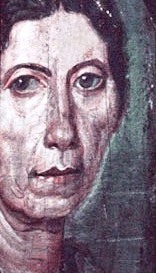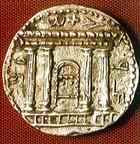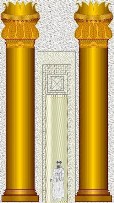The Gospel story
Who was the widow?
The woman in the story is a nobody, penniless and alone in a society that values wealth and family connections.
Why is the widow even mentioned?
What we discover is that she has something all the rich people in the Temple courtyard will never have: the admiration of Jesus of Nazareth.
Why did Jesus notice her?
In the previous chapter there has been heated discussion about a whole range of questions:
- who is God?
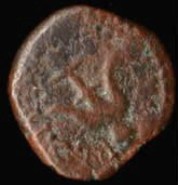
Ancient low value coin
- whom should we obey?
- what are our responsibilities?
Then the words written immediately before her story mention a recurring theme in the gospels: the way poor people’s rights are trampled on by the rich and powerful:
38 And in his (Jesus’) teaching he said, “Beware of the scribes, who like to go about in long robes, and to have salutations in the market places
39 and the best seats in the synagogues and the places of honour at feasts,
40 who devour widows’ houses and for a pretence make long prayers. They will receive the greater condemnation.”
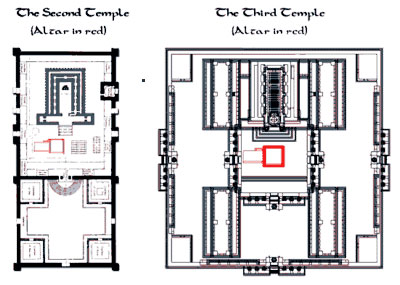
Compare the ground plans of the earlier Temple precincts with the grand Temple built by King Herod
Jesus’ pointed comment was timely. In the years immediately preceding this incident, King Herod the Great had taken over large areas of Jerusalem to extend the Temple Mount and its huge administration blocks, colleges, and priests’ quarters.
You can get an idea of this by comparing the ground plans of the previous Temple (built by Solomon and then rebuilt by Ezra) with the grand Temple built by King Herod. Above are two plans,
- one of the Temple Ezra constructed on the same scale as Solomon’s Temple,
- and the other, grander Temple Herod built at the time of Jesus.
The extra land needed for Herod’s Temple and the courtyards and buildings around it must have been gained by the demolition of existing buildings.
It’s very possible that ‘widow’s houses’ on the lower side of the Temple plateau had actually been destroyed to make way for the new Temple buildings. It’s even possible that the widow in the story had been among those robbed of their homes in this land repossession.
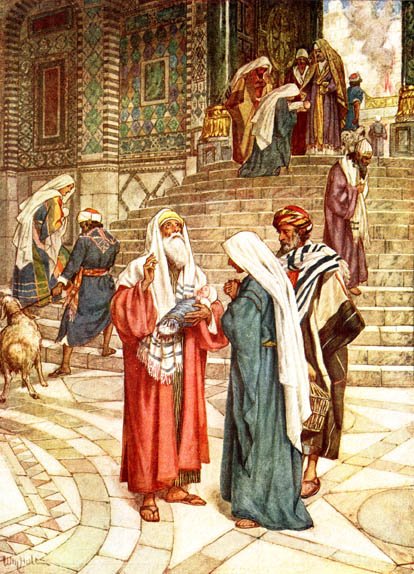
The Women’s Court led up to the Men’s Court, where women could not go. Painting by James Tissot.
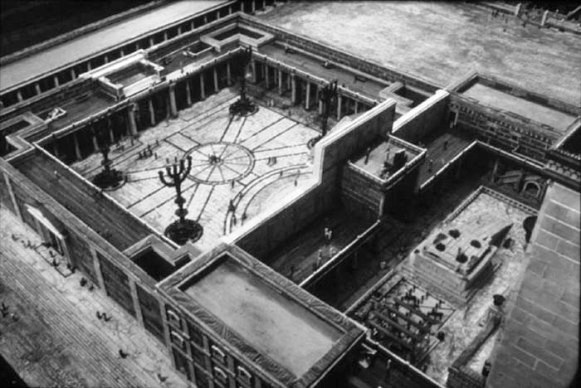
The 1st century Temple in Jerusalem, with the Women’s Court.
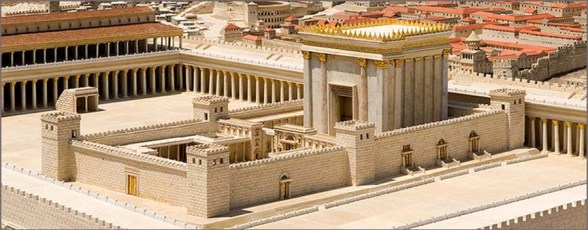
(Above) Reconstruction of the Jerusalem Temple built by King Herod the Great. The Women’s Court, where Jesus saw the widow, is the courtyard at the left of the picture.
Jesus: what are the motives of the donor?
Jesus sat at some vantage-point in full view of this part of the Temple. He was probably weary from the day’s prolonged debates.
His eye fell upon the solitary figure of a poor widow who put in two copper coins (Greek lepta, the smallest copper coin in use) which the evangelist Mark, for the benefit of his Roman readers, computes in terms of Roman coinage as equivalent to a penny.
Jesus called the attention of the disciples to the woman. She had given two of the tiniest coins in circulation (‘mites’) as her offering, alongside the large gifts of the rich.
In the sight of Jesus her gift was the greatest, for what God measures is not so much the size of the gift as what remains after it has been given.
In this particular case the donor had given her whole income.
Money in itself has no value in the kingdom of God, so Jesus refused to count totals.
Instead he looked at the motives of the donor. The essence of all true giving is sacrifice, and the value of every gift relative, not absolute.
*** Notice that in Luke’s retelling of the story, Jesus contrasts the rich donors and this poor widow not once but three times, to emphasize the glaring difference between the two sorts of people.
What was the treasury? Some information.
The ‘treasury’ mentioned in the story could have been one of two things:
- a specially designated room next to the Women’s Court or
- a receptacle for offerings; along the colonnade which surrounded the Court of the Women there were thirteen chests with trumpet-shaped openings (Hebrew sapaiw) provided for offerings from the worshippers.
The ‘small copper coins’ mentioned in the story were the smallest amount in circulation at the time of Jesus, the least valuable coin available (see an example at the top of this page).
A ‘penny‘ was the Roman quadrans, which was 1/64 of the daily wage for an ordinary worker.
The Gospel text
Mark 12:41-44
41 And he sat down opposite the treasury, and watched the multitude putting money into the treasury. Many rich people put in large sums.
42 And a poor widow came, and put in two copper coins, which make a penny.
43 And he called his disciples to him, and said to them, “Truly, I say to you, this poor widow has put in more than all those who are contributing to the treasury.
44 For they all contributed out of their abundance; but she out of her poverty has put in everything she had, her whole living.”
Luke 21:1-4
1 He looked up and saw the rich putting their gifts into the treasury;
2 and he saw a poor widow put in two copper coins.
3 And he said, “Truly I tell you, this poor widow has put in more than all of them;
4 for they all contributed out of their abundance, but she out of her poverty put in all the living that she had.”

Reconstruction of the Temple of Jerusalem in 1st century AD
Notes on the Gospel text
- 40 This story brings welcome relief after the heat of controversy preceding it, for here is one who, in her simplicity, gave to God everything she had. It was no doubt positioned deliberately by Mark, because he put the story of the devouring of widows’ houses immediately before (verse 40).
- 41 It is not certain that there was a building called the treasury (Greek gazophylakion) but along the colonnade which surrounded the Court of the Women there were thirteen chests with trumpet-shaped openings (Hebrew sapaiw) provided for the offerings of the worshippers. At some vantage-point in full view of this part of the Temple Jesus sat, probably wearied by the prolonged teaching/arguments of the day. The lesson of the whole story is that Jesus’ first concern is not what people give but how they give it. Money in itself has no value in the kingdom of God; so Jesus refused to count totals but looked at the motives of the donor (see 2 Corinthians 8:12).
- 42 Therefore when his eye fell upon the solitary figure of a poor widow who put in two copper coins (Greek lepta, the smallest copper coin in use) which Mark, for the benefit of his Roman readers, computes in terms of Roman coinage as equivalent to a penny (Greek kodrantés, a transliteration of the Latin quadrans, ‘a farthing’)
- 43, 44 In answer to the question of how Jesus came to know the amount of her gift, he may have discovered by quite ordinary means which are not disclosed; but in any case the question is irrelevant to the story. The essence of all true giving is sacrifice, and the value of every gift relative, not absolute.
Summary of the story
The story of the Widow has two parts:
1. Jesus sees her put an offering in the Temple Treasury
2. He points her out as a model of true generosity
Main themes of the story
- It is not the size of a gift that matters, but the spirit in which it is given.
- Jesus was reacting to the values (or lack of them) of King Herod the Great, who re-built the lavish Temple in Jerusalem. Sitting in the Temple forecourt, Jesus saw money, money, everywhere. This is not what God cares about, Jesus emphatically said.
Read about more fascinating women of the Old and New Testaments
Bible Study Resource for Women in the Bible:
the Widow’s Mite, Jesus’ teaching on wealth and true generosity

